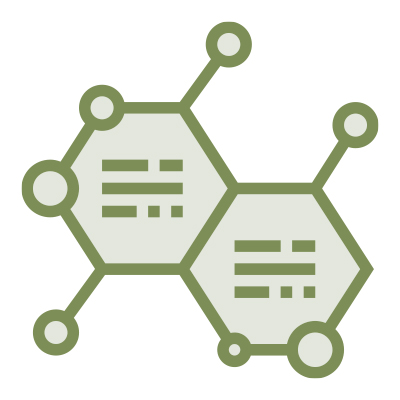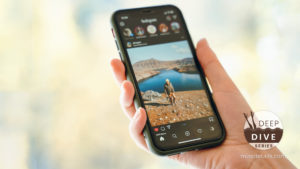
A fully developed, perfectly executed brand concept is a beautiful thing to witness.
Like a stately brick townhouse framed by ivy, or a charming suburban split-level with a beautiful garden, there’s something inherently inviting and intriguing about your branding when it purposefully connects with your audience. Like those houses, successful branding campaigns catch your attention at first glance. They inspire you to learn more: to see the interiors and to find out what else they have to offer. The brand details, like a well-manicured lawn or new window treatments, hint at the quality found throughout the business.
Quicklinks for the Full Deep Dive Series on Building a Brand
Part 1: Introduction | Part 2: Beginning Your Brand | Part 3: From Planning to Practice | Part 4: Revisit + Revise | 
Of course, the branding house is never done. There’s always another room to re-paint, some furniture to update, and new appliances to install to help everything work together. The responsible homeowner is always looking around for problems or even potential problems, staying ahead of the curve to avoid catastrophe, like when that loose floorboard in the bathroom leads to a leak in your kitchen ceiling.
Similarly, smart business owners and marketing managers should always check back in on various aspects of their branding and messaging, ensuring current connectivity while preparing for future success.
Even if your brand is doing wonders for your business, there are a few things to keep in mind as you move into the future.

Consistency ≠ Stagnation
It can be tempting to want to inject change into your branding before too long. And variety is certainly a good thing—you don’t want your customers to repeatedly see the same posters, to get the same emails, and to hear the same stories. But that doesn’t mean you need to reinvent the wheel every year. Staying consistent to your brand doesn’t require stagnant marketing, but it does mean keeping some things.
One company that has perfected the concept of consistency without stagnation is GEICO. Founded in 1936 as the Government Employees Insurance Company, GEICO opened up to the general public in the 1970s and has since become one of the largest insurance providers in the world, with revenues over $35 billion in 2019.
GEICO’s most recognizable branding asset is its all-too-familiar gecko, the cute-but-nameless green lizard with a British accent which first popped up (voiced by Kelsey Grammar) in 1998.
But GEICO’s advertising hits have included much more than the gecko.
There were the cavemen, which became so popular that ABC even (briefly) attempted a TV show featuring the characters. There’s Maxwell the Pig, who starred in a commercial about him crying all the way home, though he’s also appeared in a number of ads since. There have been parodies, misdirection, celebrity endorsements, and so much more. Recently, GEICO has released a series of advertisements that feature people complaining about common household problems like a “fencing problem” or “ant troubles,” only for it to turn out their issues are sword fighting neighbors or a number of obnoxious aunts.
All of these campaigns, as varied as they are, tie back to GEICO’s central branding: approachable, relatable, personable, friendly, and humorous. GEICO is unwavering with their main brand elements; the logos, fonts, and colors. Their marketing campaigns might change but the brand stays consistent.

Next Step: Brand Evolution
It’s possible, but unlikely, that for as long as your business is around, you won’t need to do a major overhaul of your branding and messaging.
If your business is like most, it will change over time. Whether that’s going from a local, family-owned business to a major corporation; pivoting your main product or service; going with an entirely new attitude and approach; changing your demographic, or any other significant change, whatever you do will almost certainly necessitate a revisit of your brand strategy and branding assets.
These changes might be subtle. They might happen slowly, or be a series of minor changes that don’t feel significant at the time, but all push you in a singular direction away from your starting point. Keep in mind that it might end up being your industry that changes, with the customers’ expectations shifting along the way, and your brand must do something to keep up.
That’s where all the preparation you’ve done along the way makes a huge difference. It allows you to identify which aspects of your branding need work, and to use the lessons from your past to influence the choices of the future. Think about your competitive analysis, your personality, your core guides, and your A/B testing results. Even if you need to perform new research and try new options, that earlier data will still prove useful.
In rarer cases, you’ll need to start from scratch again: to buy a new plot and build a new house. When that happens, it’s time to turn back to Part One of this series on building a brand, and begin all over again.
Coming Up Next…
We’ll get back to our Deep Dive series later this year with our next in-depth feature. Until then, we’ll be experimenting with all different types of blog content: brand evaluations, client spotlights, industry information, tips & tricks, and so much more. Don’t forget to sign up for our Brand Builders Newsletter below to stay on top of everything Miss Details has to offer your growing business.
Don’t want to miss out on our articles and insights?
Sign up for the Miss Details newsletter today.
Learn More with our Deep Dive Series
About Miss Details
Founded by Tanya Gagnon in 2004, Miss Details is a full-service branding and design firm which helps entrepreneurs and companies launch, adjust and reinvent key aspects of their branding and business marketing strategy. With a background in all aspects of interior and experiential design and a passion for data-backed design, Tanya leads the Miss Details team to guide her clients through everything from a refreshed website to a full rebranding, helping them put the pieces together to create a consistent, authentic, unique brand image.



